When it comes to obscure and interesting pepper varieties, many originate from the pimenta da neyde. This dark purple, almost black pepper variety has an enigmatic origin story, but we do know some things.
So, in this article, I’ll share everything I know about the pimenta da neyde pepper, including its origin, plant characteristics, appearance, flavor, and heat.
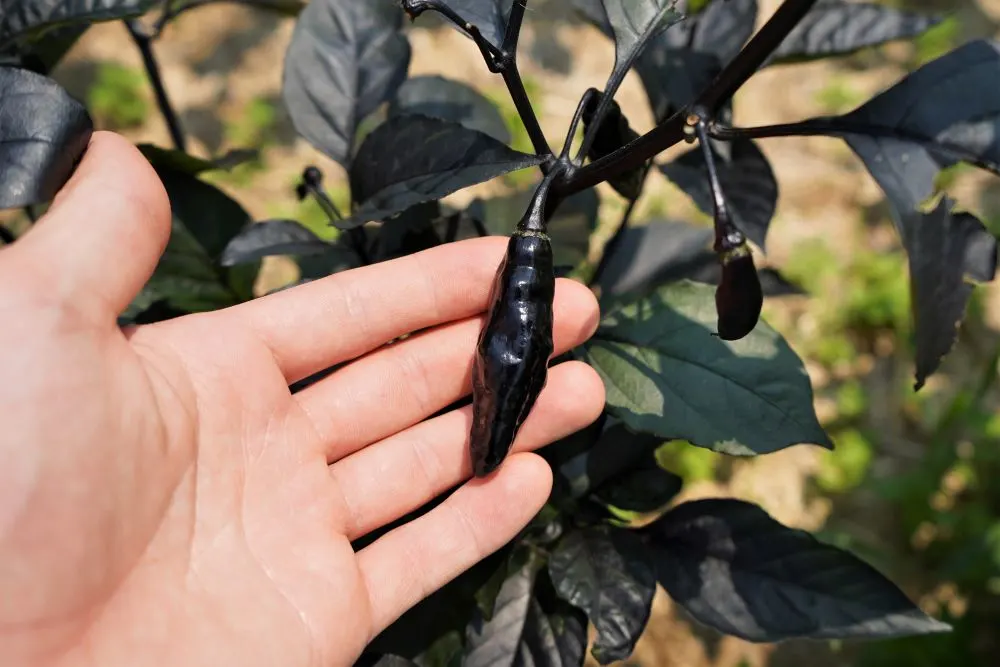
Pimenta da Neyde Origin
It is widely accepted that the pimenta da neyde was discovered in Brazil by a woman named Neyde Hidalgo (Hidalgo da Neyde). It is believed to be an accidental cross between a Capsicum annuum variety and a C. chinense variety.
As a result, the plants are tall and sturdy like many annuum types, but have a habanero-like flavor and aroma. Fruits are 2-3 inches long by about a half inch wide.
Pimenta da Neyde Pepper Appearance
Pimenta da neyde plants produce oblong fruits that are a deep purple, almost black color. Unlike virtually all other pepper varieties, the peppers do not noticeably change color when ripe.
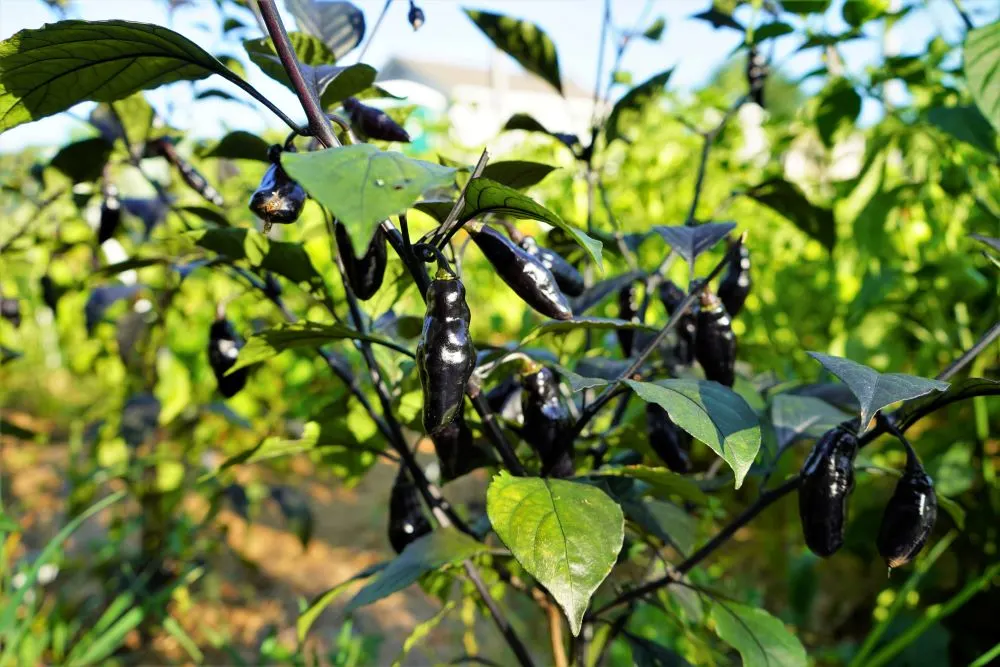
The only way to know a pepper is ripe is to observe the inside, where the placenta will be either green (unripe) or purple (ripe). This makes harvesting the peppers tricky, as ripe fruits taste better.
Why are they so dark? The dark color of the leaves and peppers is thanks to high anthocyanin levels. This compound is known as the ‘purple pigment,’ and is activated by sunlight. The parts of the plant that are shaded are not nearly as dark as those in direct sunlight.
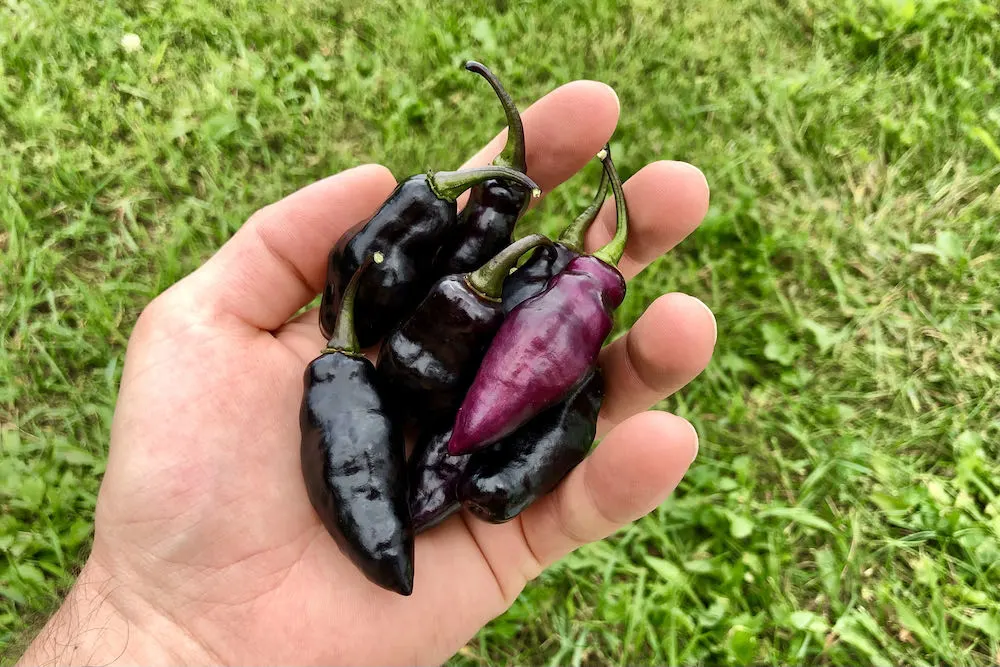
The same goes for the fruits, with shaded fruits having a lighter purple color. As a result, the plant puts on a beautiful show throughout the season, making it a great ornamental variety. It has also been a common plant in the world of crossbreeding with other superhot peppers, resulting in a wide range of new hybrids.
Pimenta da Neyde Pepper Scoville
Pimenta da neyde peppers are spicy! They look somewhat tame with their smooth skin, but they pack a respectable punch.
In short, the pimenta da neyde comes in between 150,000-250,000 SHUs on the Scoville scale. This places is right around habanero heat, which is quite significant.
Pimenta da Neyde Flavor
If you want to grow the best tasting hot pepper, the pimenta da neyde is likely not the right choice. While the flavor is okay, it is certainly not a favorite.
The taste is slightly bitter with floral notes, similar to a habanero. This doesn’t work well in many culinary situations, but the color alone may be useful in cooking. The fresh peppers bleed when cut open, staining food with gorgeous, vibrant purples.
Growing Pimenta da Neyde Peppers
Growing the pimenta da neyde is exciting from the moment the seedlings sprout. The dark, purple and green foliage is gorgeous, even on the cotyledons.

Also, growing this variety is easy. If you’ve grown jalapenos, you’ll have no trouble with growing pimenta da neyde. The variety has both Capsicum chinense and annuum genetics, making for a tall, sturdy plant with large yields.
I also noticed that this plant seemed to be disease resistant. Other nearby plants dealt with fungal issues while the neyde (and other dark foliage varieties) had no problems at all.
The only issue we did have was with deer chomping off branches. However, this was likely due to the plant being located on the edge of the garden, near a wooded area.
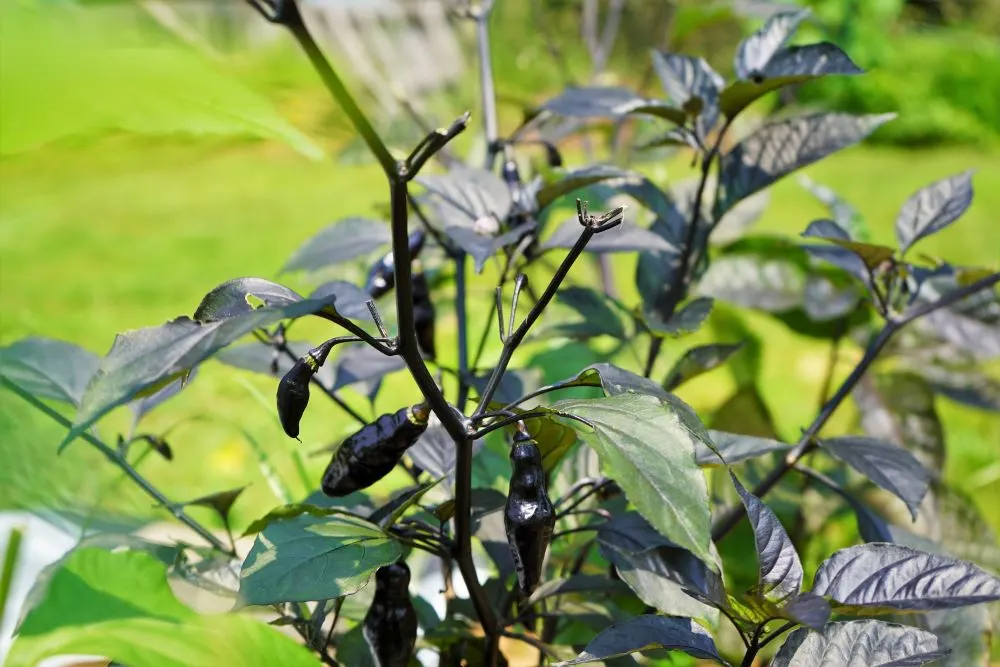
Pimenta da Neyde Crosses (Hybrid Varieties)
Dark foliage is unique and exciting for pepper growers, so it is no surprise that the pimenta da neyde has been crossbred with countless other varieties. The result is a plethora of interesting, dark foliage C. chinense pepper varieties. Here are a few we have grown and loved.
Purple Reaper
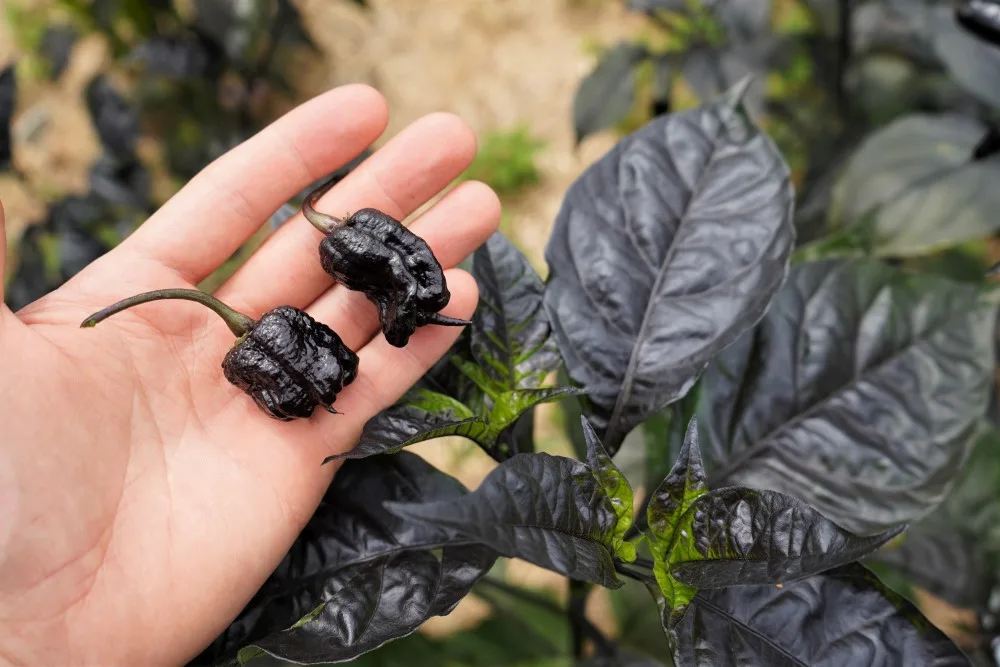
Ever heard of the Carolina reaper? Well, the purple reaper is the dark foliage variant, undoubtedly sharing some genetics with the pimenta da neyde. The plant is huge, prolific, and vigorous, producing several dozen super spicy reaper-shaped purple peppers!
Black Panther
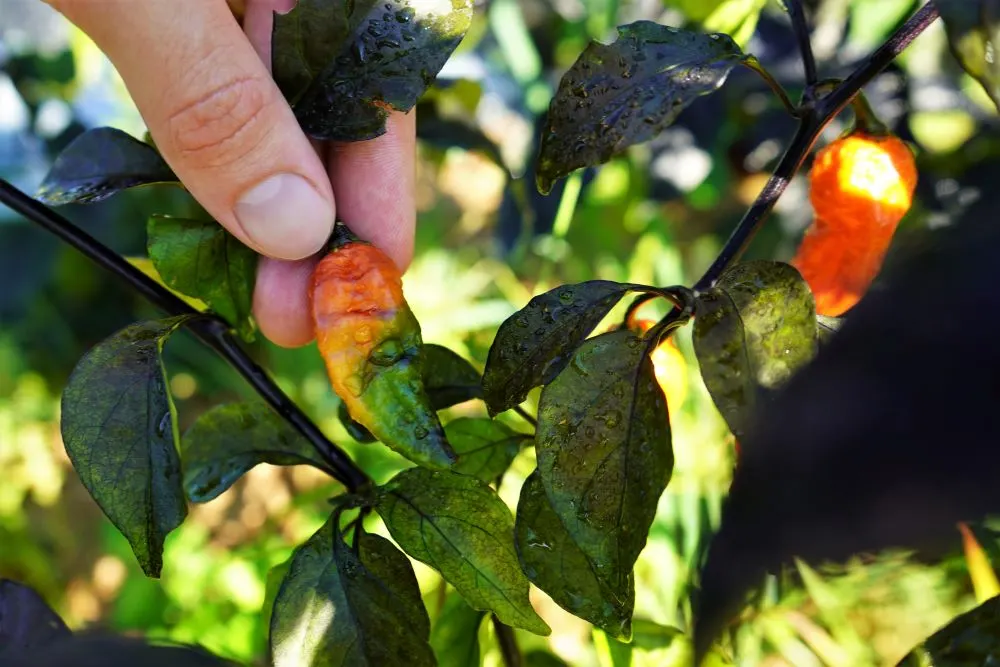
The black panther pepper was originally a cross between the pimenta da neyde and the bhut jolokia. The result is a superhot pepper that resembles the gnarly ghost pepper, but has dark foliage and dark unripe fruits. Watching the peppers ripen from purple to orange or red is a marvel!
Peachgum Tiger
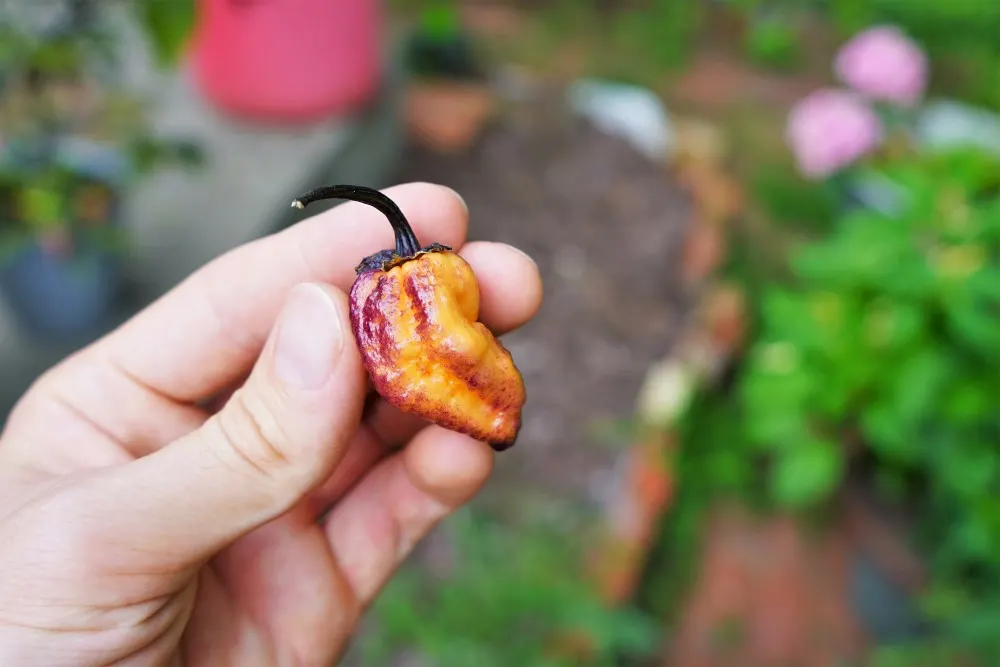
The peachgum tiger is a newer variety that is a cross of a cross. If you go back far enough, the genetics lead back to the pimenta da neyde, giving the plants their purple foliage and dark unripe fruit color.
The pimenta da neyde was a turning for the pepper community, helping to bring some of the most notable and beautiful varieties into existence. I hope this article inspired you to grow some new pepper varieties. Cheers to Hidalgo da Neyde!


David Niemi
Sunday 3rd of December 2023
I had an accidental cross in 2023 between a Tabanero (c. chinense x c. frutescens) and a Pimenta de Neyde. Pods started out dark purple but eventually ripened to red, with a flavor between the two (nicer taste than the original Pimenta de Neyde but more floral than most Tabaneros). Very big strong plant with dark stems and dark green leaves. So intermediate between the two varieties on several levels. A supposedly pure Pimenta de Neyde I had in the sunnier garden grew funky looking pods with stingers, but with the typical Chinense taste. I find that the pods of regular Pimenta de Neyde get a bit lighter and pinker in color when ripe.
Noam
Saturday 10th of June 2023
I'm trying to grow this pepper but while the plant itself seems to be doing well and growing, the flowers keep falling off. Any idea as to why and how to prevent it from happening?
peppergeek
Monday 12th of June 2023
Usually, this happens early in the season while the plants are growing larger, or if the temperatures are too hot. Also, over-fertilizing can cause lower yield.
Jack
Thursday 15th of September 2022
I have a “Black pepper” variety but it changes to red when ripe. Purple flowers, black on foliage, pretty hot. Looks very much like da Neyde
peppergeek
Friday 16th of September 2022
Hmm, there are many annuum types with dark foliage and fruits that ripen to red - this is likely how the neyde got its dark foliage, by crossing with an annuum! Look into the black pearl, black prince, and hungarian black for a few examples.
Shadowcat
Saturday 6th of August 2022
Bitte and flowery?? Like habañero? Hrrm, im still very curious about this one, qnd it will be not the only plant i have. I will have a kind of cayenne and tasmanian chillis too.
Im not sure if i will like the taste, hate it? Find it acceptable.... But im still curious enough 😺
So, they dont change their colour if ripe? Will the fruita at last be soft if i touch them?
peppergeek
Sunday 7th of August 2022
They did seem to soften after they fully ripened. None of them changed color at all, only on the inside (from green to purple), and I left a few on the plant until they rotted just to test it! Very strange and unique, even in the pepper world.